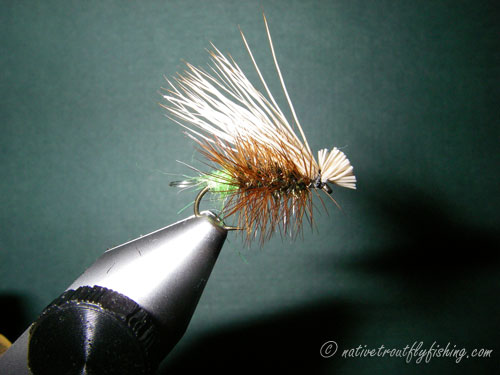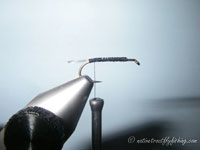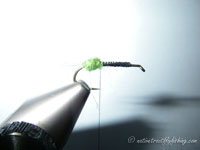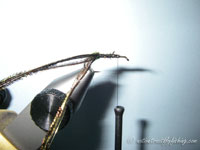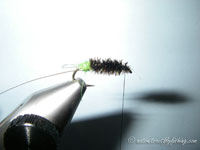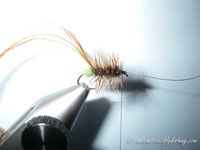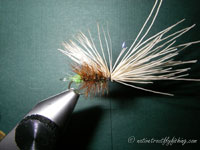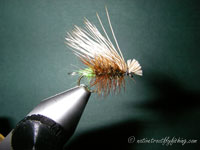Hot-Butt Dropper Caddis
Overview
|
Hook: |
Daiichi 1180 size 14-18; 12 is a great small stream attractor size |
|
Thread: |
Brown or Tan 8/0 thread |
|
Dropper Loop: |
8lb maximum fishing line |
|
Egg Sack: |
Any fine caddis green or chartreuse dubbing |
|
Rib: |
X-small gold wire |
|
Body: |
Peacock Herl |
|
Hackle: |
Brown dry fly grade hackle |
|
Wing: |
Bleach elk hair |
|
Notes: |
This is my go to fly to match the Mother's Day caddis hatch on the Yakima River. These early May Grannom Caddis flies have a dark body matched perfectly by peacock herl. I always like the concept of the dropper as it doubles your chances and the loop addition to this fly makes for a more efficient ride. This pattern also makes for a great small stream searching and attractor pattern throughout most of the season. |
Tying Instruction
Click on images to view a larger picture
|
Step 1: Start the thread about 1/3 of a shank length behind the eye. Tie in a length of 8lb mono to form a small loop extending past the bend of the hook. This will act as a second "eye" to tie tippet onto for a dropper. Once the mono loop has been secured coat the thread wraps with a small amount of Zap-A-Gap. |
|
|
Step 2: Create a small ball of dubbing at the rear of the hook. The dubbing ball should extend from about the barb to the point of the hook. |
|
|
Step 3:Tie in about a four inch length of fine gold wire and four strands of peacock herl. I like to tie everything in starting about 10% of a shank length behind the eye of the hook and wrap back to the dubbing ball. This will keep the body nice and even. Once everything is all tied in, bring the thread back up to 10% behind the eye. |
|
|
Step 4: Spin the peacock herl strands together to create a rope and wrap it up to the 10% point behind the eye to form the body. |
|
|
Step 5: Tie in a brown hackle feather butt first just in front of the body. Wrap the hackle back palmer style to the ball of dubbing. Remember that the more wraps that you do the higher this fly will ride. Now counter wrap the wire up the body and through the hackle to form the rib and tie it off behind the eye. This will also hold the hackle down. |
|
|
Step 6: Cut a good sized clump of bleached elk hair and use a hair stacker to even up the tips. I like to tie in the hair just slightly long than the hook shank and it is important to make sure that it is centered over the top of the hook before tying it down. It is important to first make a couple of loose wraps than increase the tension and make several tight wraps. |
|
|
Step 7: Trim the butts of the hair fibers down to just in front of the eye of the hook and whip finish and head cement |
Contact
Feel free to contact me if you have any questions or comments
Native Trout Links
California Heritage Trout Challenge
Truchas Mexicanas' - Native Trout of Mexico
Balkan Trout Restoration Group
Trout and Seasons of the Mountain Village - About Japanese Trout
Fly Fishing Blogs
Dave B's Blog: Fly Fishing for Native Trout
The Search for Native Salmonids
Conservation Links
Western Native Trout Initiative
Fly Fishing Links
Fishing Art Links
Americanfishes.com - Joseph R. Tomelleri
Fish Eye Guy - Underwater Trout and Salmon Pictures
